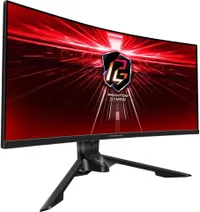Step into the world of ultrawide gaming with this 34-inch 2K curved monitor for just $295
It's the best budget ultrawide you can buy right now.

ASRock Phantom Gaming PG34WQ15R2B | 34-inch | 1440p | 165 Hz | VA panel | 1500R curve | $379.99 $294.99 at Newegg (save $85)
For the ultimate in gaming immersion, it's pretty hard to beat a huge, ultrawide, curved monitor. Normally they're really expensive but not this one, and you're getting a whole lot of display for very little money.
Price check: Amazon $361.99
Given that this ASRock display is our recommendation for the best budget ultrawide monitor, we would obviously suggest buying it at its normal MSRP of $369. But when it's a cent under $295? That will do very nicely, thankyouplease.
Until you've gamed on a big, curved, ultrawide monitor, it's a little hard to appreciate just how much it does for the gaming experience. You really do feel drawn into the world and depending on what game you're playing, it can make a traditional flat-panel monitor look dull in comparison.
So what exactly are you getting for your 295 dollars? The ASRock Phantom Gaming PG34WQ15R2B (a name that just rolls off the tongue) sports a 34-inch VA panel, with a resolution of 3440 x 1440 and a refresh rate of 165 Hz. Sure you can get better ultrawides than this but certainly not at this price.
That VA panel isn't the fastest you'll come across but it offers a really good HDR experience, even though it's not an OLED. As we found when we reviewed this monitor last year, SDR content looks really good when you run the display in HDR mode. "Running a game like Cyberpunk 2077 does actually look punchier and more dynamic in HDR mode, which is far from universally the case for this class of monitor," said our monitor expert Jeremy.
It's only certified to DisplayHDR 400 and doesn't have local dimming, so it's not the greatest HDR experience you can have but it's far better than any IPS monitor, that's for sure.
VA panels aren't as quick as IPS or OLED displays, and the fast MPRT (mean pixel response time) mode ruins the overall brightness. Using the switchable pixel overdrive also incurs some overshooting and inverse ghosting, but it's actually not too bad at all.
Personally, I recommend that you just put it into HDR mode, spend a bit of time calibrating the monitor to get the right balance of color, brightness, and contrast, and then leave it alone—it'll be great for gaming and media consumption.
You will want to use the single DisplayPort 1.4 port, rather than either of the two HDMI 2.0 sockets, as the latter only supports a 100 Hz refresh rate. To get the full 165 Hz, it's DP or nothing. You don't get any extra USB ports either, though for some odd reason, you do get a built-in Wi-Fi antenna. Odd but not entirely unwelcome.
Rounding off the positives, the Phantom Gaming PG34WQ15R2B has support for FreeSync Premium variable refresh rate, a gentle 1500R curvature, and a fully adjustable stand. All for $295!
Newegg has somewhat cheekily added an extra $10 onto the original MSRP, so the actual saving in reality is just $75 when compared with the proper $369 sticker price, but even so, this is the perfect way to step into the world of ultrawide gaming without requiring an ultrawide bank balance. And you can't ask for more than that.
Keep up to date with the most important stories and the best deals, as picked by the PC Gamer team.

Nick, gaming, and computers all first met in the early 1980s. After leaving university, he became a physics and IT teacher and started writing about tech in the late 1990s. That resulted in him working with MadOnion to write the help files for 3DMark and PCMark. After a short stint working at Beyond3D.com, Nick joined Futuremark (MadOnion rebranded) full-time, as editor-in-chief for its PC gaming section, YouGamers. After the site shutdown, he became an engineering and computing lecturer for many years, but missed the writing bug. Cue four years at TechSpot.com covering everything and anything to do with tech and PCs. He freely admits to being far too obsessed with GPUs and open-world grindy RPGs, but who isn't these days?


